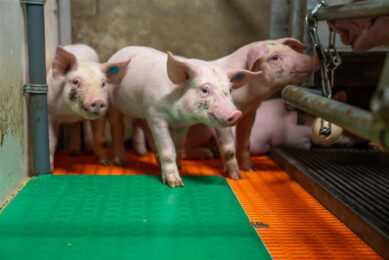The high level zinc oxide ban (II)

The European Commission opted for phasing out the usage of high-level zinc oxide. EU farmers have 5 years to figure out what is next. John Gadd follows up from his earlier expert opinion – and sums up some countermeasures.
The ZnO ban is likely to cost at least €2.50 per pig at slaughter and double that if there is a scour outbreak in a third of the post-weaners. So in its absence, what countermeasures can the producer take?
Long-term measures for pig producers
There are long term and short term measures and I’ll deal quickly with two of the ‘long-terms’.
The first is to have milky sows who are good mothers. This was brought to our attention in a sharp reminder when we changed from large, placid Accredicross sows – lovely sows to work with, but whose progeny were not up to the low food conversions and fast growth advantages of one of the more ‘streamlined’ lines we changed-to so as to keep abreast of the times.
Understanding post-weaning troubles
It took a year of diligence before we got on top of the noticeable rise in post-weaning troubles. This was 20 years before high-level zinc was ever thought of. Geneticists – please factor-in more placidity and mothering quality into your gene mixes, excellent as they now are. Good mothers make for heavier, more even litters; less post-weaning trauma. Greater attention is needed on these 2 factors, so this old warhorse thinks.
The next palliative starts really early-on in the breeding cycle and that is to avoid stressing the sow at implantation. This causes, among other things an uneven timing of the ‘take’ of the fertilised blastocysts on to the womb surface eventually resulting in uneven birthweights – and later on, more squabbling due to differential weights during ‘peck-order’ establishment at weaning and increased stress among the mixed pens.
There are 2 theories why uneven receptivity occurs at implantation – past research wisdom, recognition of which seems to have dimmed since they and the possible answers were outlined 25 years ago. Less post-weaning trouble was one result. I’ll do a couple of pieces on them both to remind us all of the good sense behind it.
Short term suggestions
Last time I covered the importance of modern design of post-weaning food and why it is important to cease complaining, however understandable, about their cost per tonne. But the paybacks by slaughter from feeding what many consider ‘gold dust feed’ is still, from my clients’ records, 2.8:1 by slaughter weight, and sometimes double that.
This is when measured at slaughter, when every extra kg secured shortly after weaning can be as much as 3 times more by slaughter weight. To achieve this extra boost, the feeds have to be fed properly, cleanly, with adequate water as they are thirst-making.
Try to add water points (extra box-shape canister types at post-weaning) between feed hoppers and provide some extra feed containers for a while. Some of the secrets of little post-weaning trouble is to keep the weaners happy. Stress causes both physical (external) and physiological (internal) damage, slowing performance to slaughter.
Common causes of stress in weaners
My list of points below suggests some common causes of stress in weaners. They seem obvious, don’t they, but I see at least one of them on nearly every nursery I visit, even in these days of better-trained stockpersons.
On asking why, 2 failings predominate.
- Not enough time is devoted to the farrowing to end-of-nursery period, often only 6% of labour cost when it should be 16%, with post- weaning management needing about a fifth of that – it is that important so as to secure that 3 to 1 boost to slaughter.
- Also, stockmen don’t measure things sufficiently, which may be the owners fault, but if the devices exist, are slow in acting on them. Digital devices are now reliable and useful and the era of interreaction between them, especially post-weaning, is becoming exciting. As to cost, stand-alone or combined, they are becoming very affordable in terms of payback. This is the future of technical stockmanship. Rightly so, as apart from better performance results it makes the job so much more interesting.
Some of the more important stressors post-weaning
- Food: poor palatability, presentation and formulation;
- Thirst: sophisticated modern diets are thirst-making;
- Overcrowding and lack of ‘fleeing space’;
- Too disparate weaning weights;
- Too hot or too cold;
- Draughts at night;
- Poor flooring;
- Gases;
- Dust;
- Insufficient feeding space;
- Badly-sited feed hoppers;
- Unfamiliar, noisy stockpersons.











